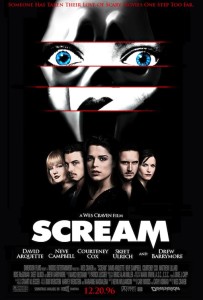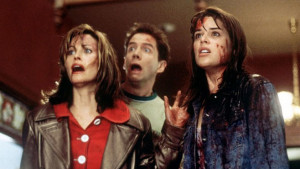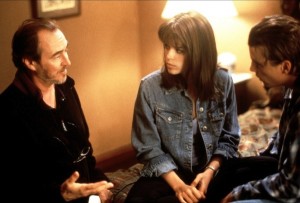Cinema Revisited: The Postmodern Horror of Wes Craven’s Scream
With the advent of the Internet, postmodernism found the perfect vessel. Today, a few clicks and an enter button can thrust you into any realm you so chose – along with a wink and plenty of ironic air quotations. This practice hasn’t solely applied to the common consumer either; tastemakers and artists have also sought this chic alternative in their works. Charlie Kaufman writes about his fictional self in Adaptation (2002), dreams become genres within themselves in Inception (2010), and a super- (anti-) hero mocks comic book movies in next year’s Deadpool.

Or perhaps more tellingly, Scary Movie. That was the original title that Craven and screenwriter Kevin Williamson chose in an effort to convey their groundbreaking blend of horror and satire. Williamson borrowed heavily from the real-life Gainsville Ripper, but his more notable inspirations would lie in slasher movies of the 1970s and 1980s. Stuff like Halloween (1978), When A Stranger Calls (1979), and Craven’s own A Nightmare On Elm Street (1984).
A Nightmare on Elm Street in particular would take on a whole new level of inspiration once Craven was appointed director – edging out candidates like George A. Romero, Sam Raimi, and Robert Rodriguez with his chilling body of work. Wes had spent the last decade paddling around in decent horror flicks like The Serpent and The Rainbow (1988) and People Under the Stairs (1991), but nothing had truly hit since Freddy Krueger’s first appearance. As a result, Craven began tinkering with scary movie conventions in 1994’s New Nightmare; a bizarre meta-slasher where several of Scream’s overlapping realities would first appear. The director couldn’t wait to deconstruct the genre he himself had pioneered. Horror was about to join the postmodern age with one simple question.
“What’s your favorite scary movie?” has become the iconic line of Scream. It’s also the first thing growled over the phone at Casey Becker (Drew Barrymore) in the film’s opening sequence. In a conversation that throttles from flirtatious to fearful to just flat out frightening, it’s a murder scene that immediately sets up the narrative tone of blood-soaked pop culture. In the midst of a surprise celebrity death that echoes the original slasher film, Psycho (1960), we get to remind ourselves that Jason’s mom was indeed the killer in Friday The 13th (1980). It’s horrific enough to see Drew Barrymore get butchered, but to have it be because of that trivia flub? Come on, Drew. Hopefully the other victims watched more movies during Halloween season.

Craven also introduces a new breed of slasher movie character with Randy (Jamie Kennedy), the horror movie savant. If Scream played out like some knife wielding retelling of Pinocchio, then Randy would be Jiminy Cricket in a bowling shirt. His fourth-wall acknowledgement of slasher film shortcomings is the running gag of the story, complete with some of the script’s best lines (“If they’d watch Prom Night they’d save time! There’s a formula! A simple formula!”)
Craven, Williamson, and Randy lay out the proverbial slasher rules that are followed to this day, just in case they ever come in handy. The breakdown goes as follows:
- Never have sex (cue crowd boos).
- Never drink or do drugs (cue bottle raises).
- Never, ever, ever under any circumstances say, “I’ll be right back” (cue crowd leaving).
Do the rest of the characters follow this three-step template? Of course not. And that’s what makes Scream such an ironic dose of satire. Craven mocks the rulebook while simultaneously following its every word, as if fulfilling some morbid curiosity of just how far clichés can be bent. Characters relate situations to scary movies they’ve seen, yet they don’t do much better when it comes to acknowledging their own bad decisions.

As each hyper-violent Wes Craven murder brings us closer to the third act, the struggle to peg a suspect becomes frustratingly tough. Despite being tossed clues and slasher rules for 100 minutes, the self-mockery of the movie keeps us from believing anything tossed our way – even when it plays out in predictable fashion. It’s obviously curtains for Sidney when she gives up her virginity to Billy (see rule #1), but things remain just as shocking when he reveals his murderous plans (19-year-old spoiler). Check off surprise murderer, now all that’s needed is a blood soaked finale and a motive.
Well, the motive is arbitrary, really. Billy murdered everyone as revenge for his mother’s affair with Sidney’s dad. Big whoop. The real juice comes in with loony lines like “it’s all a movie. One great big movie,” as he licks fake blood off his fingers and explains its similarity to the Carrie (1976) recipe. Sidney eventually double taps the worst ex in film history and assumes the mantle of horror movie heroine originally held by Jamie Lee Curtis. All this while Halloween quietly plays in the background.

Every scary movie crafted in the wake of Scream owes incredible influence, from I Know What You Did Last Summer (1997) and Urban Legend (1998) to the five hundred Scary Movie parodies that arrive every few months. Contemporary slashers that try to play it straight only affirm their goofiness in the light of Scream’s cliché exposé. Hell, even the “found footage” craze of the late 2000’s attempted to be as pop culture savvy as Sidney and her pals.
Nothing comes close, but that’s to be expected when pitted against the first slasher classic of the postmodern age. Scream was, and will always be, the film that bridged the gap between classical and modern horror. Wes Craven may have since passed, but his creativity and ability to manipulate the past isn’t going away anytime soon. Scream will continue to resonate across the globe as long as someone has the gall to ask that daunting question: “What’s your favorite scary movie?”



Latest posts by Danilo Castro (see all)
- The 20 Best Detective Movies of All Time - February 16, 2016
- Life & Death: Ranking the Films of Alejandro González Iñárritu - January 6, 2016
- Evolution of a Champ: The Rocky Film Saga - November 25, 2015


